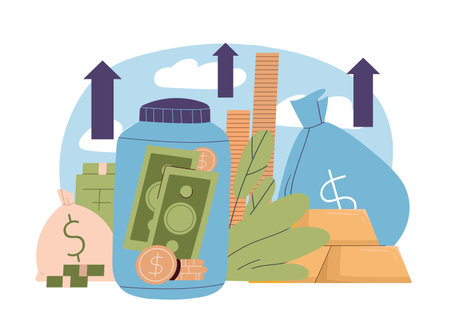Introduction to Peer-to-Peer Lending in India
Peer-to-peer (P2P) lending has emerged as a popular alternative investment and credit option in India, transforming the way individuals access loans and invest money. Over the past decade, the Indian P2P lending landscape has witnessed rapid growth, driven by increasing digital adoption, the rise of fintech startups, and the need for more accessible financial solutions beyond traditional banks and NBFCs. Unlike conventional banking, P2P platforms connect borrowers directly with individual investors through online marketplaces, enabling faster loan disbursal and often more competitive interest rates. The Reserve Bank of India (RBI) recognized the potential and risks associated with this sector, introducing regulatory guidelines in 2017 to safeguard both lenders and borrowers. These regulations include mandatory registration of platforms as NBFC-P2P entities, strict KYC norms, limits on lending exposure, and transparency requirements. Culturally, borrowing for personal or business needs has long been common in India, often relying on informal sources such as friends, family, or local moneylenders. P2P lending offers a tech-driven, transparent alternative that aligns with Indias growing appetite for digital financial services while catering to both urban professionals seeking higher returns and small-town entrepreneurs searching for quick credit. This evolving ecosystem sets the stage for a comparison of the top peer-to-peer lending platforms currently operating in India.
2. Key Features to Consider in Indian P2P Platforms
When comparing top peer-to-peer lending platforms in India, it is essential to evaluate specific features that directly impact both investors and borrowers. The unique regulatory environment and financial landscape in India mean that certain criteria should be given special attention. Here are the most important factors to look for:
Interest Rates
Interest rates on Indian P2P platforms can vary widely depending on borrower profiles, credit assessment, and platform algorithms. While some platforms offer fixed rates, others provide dynamic rates based on risk categories. Higher interest rates may attract investors but could also indicate higher risk for defaults.
Loan Tenures
P2P loans in India generally range from a few months up to 36 months or more. Flexible tenure options allow borrowers to choose repayment plans suited to their cash flows, while investors can select durations aligning with their liquidity preferences.
Minimum Investment Requirements
Different platforms have varying minimum investment thresholds, which is crucial for new or small-ticket investors. For instance, SEBI guidelines require a minimum investment of ₹5,000 per borrower and a maximum exposure limit of ₹50 lakh across all P2P platforms for individual lenders. The table below summarizes typical requirements:
| Platform | Minimum Investment (INR) | Maximum Exposure (INR) |
|---|---|---|
| Lendbox | ₹10,000 | ₹50 lakh* |
| Faircent | ₹5,000 | ₹50 lakh* |
| LenDenClub | ₹500 | ₹50 lakh* |
*As per RBI guidelines for all P2P investments.
Risk Management & Credit Assessment
Indian P2P lending platforms deploy proprietary algorithms and strict credit checks to minimize default risks. These include evaluating CIBIL scores, income proofs, employment stability, and social profiles. Some platforms even offer partial principal protection or recovery support services tailored for Indian conditions.
KYC & Regulatory Compliance
KYC (Know Your Customer) processes are mandatory as per RBI regulations. Platforms use Aadhaar-based eKYC, PAN verification, and bank account validation to ensure compliance and security. These processes help build trust among users and safeguard against fraudulent activities common in the Indian digital ecosystem.

3. Top P2P Lending Platforms: Snapshot and Unique Selling Points
Indias P2P lending sector is buzzing with innovation, offering borrowers and investors a digital avenue to access credit and generate returns. Here’s a quick overview of the leading P2P platforms that have made their mark in the Indian fintech space:
Faircent
Snapshot:
Faircent is one of Indias oldest and most trusted P2P lending platforms, known for its transparent operations and vast user base.
Unique Selling Points:
- Rigorous Risk Assessment: Faircent employs a robust credit evaluation system, helping lenders make informed decisions.
- Diversification Tools: The platform offers tools to diversify investments across multiple borrowers, reducing risk for investors.
- PAN-India Reach: With a widespread presence, Faircent caters to borrowers and lenders across metros and tier-2/3 cities.
Lendbox
Snapshot:
Lendbox is known for its tech-driven approach and seamless user experience, attracting millennials and urban professionals.
Unique Selling Points:
- Flexible Investment Options: Lendbox allows investors to start with as little as ₹10,000, making it accessible to young Indians.
- Innovative Products: Features like ‘Salary Advance’ cater specifically to salaried employees seeking short-term loans.
- Advanced Analytics: Lenders benefit from in-depth analytics and portfolio management tools.
RupeeCircle
Snapshot:
RupeeCircle stands out for its focus on financial inclusion, targeting underserved segments in semi-urban and rural India.
Unique Selling Points:
- Social Impact: By supporting borrowers who lack access to formal banking, RupeeCircle fosters grassroots entrepreneurship.
- Stringent Verification Process: Ensures safety for both investors and borrowers through rigorous background checks.
- User-Friendly Interface: Simple onboarding process tailored for first-time digital users in Bharat.
LenDenClub
Snapshot:
This Mumbai-based platform has quickly gained traction due to its fast disbursal times and high liquidity options for investors.
Unique Selling Points:
- Instant Loans Feature: Borrowers can get loans within 24 hours, appealing to those facing urgent fund requirements.
- No Middlemen Fees: Direct lender-borrower connections help maximise returns for investors.
- Diverse Loan Categories: From personal loans to education finance, LenDenClub covers varied needs of Indian consumers.
i2iFunding
Snapshot:
A platform that blends technology with strong risk mitigation practices, i2iFunding attracts cautious investors looking for detailed loan analysis.
Unique Selling Points:
- Principal Protection Scheme: Offers partial principal protection for select investment products, addressing investor concerns about defaults.
- Bespoke Investor Services: Tailored advisory services help high-net-worth individuals diversify their portfolios smartly.
- Simplified KYC & Onboarding: Designed for hassle-free account setup even for first-time users from smaller towns.
The Bottom Line
The top Indian P2P lending platforms are not just competing on interest rates—they’re differentiating themselves through user-centric features, advanced technology, social impact initiatives, and unique risk management tools. Whether you’re an aspiring investor from Bengaluru or a small business owner in Lucknow seeking funds, these platforms offer tailored solutions that reflect the diversity and dynamism of Indias financial landscape.
4. User Experience and Customer Support in Local Context
When comparing India’s top peer-to-peer lending platforms, user experience and customer support are crucial, especially given the country’s diverse demographic and linguistic landscape. Indian users expect intuitive interfaces, hassle-free onboarding, and prompt support in their preferred languages.
User Interface and Ease of Onboarding
Most leading P2P lending platforms in India like Faircent, Lendbox, and i2iFunding have invested significantly in creating easy-to-navigate websites and mobile apps. A simple registration process, minimal documentation, and quick KYC verification are common features. Many platforms now offer Aadhaar-based eKYC to further streamline onboarding for both urban and rural users.
Comparison of Onboarding Features
| Platform | Onboarding Process | KYC Method | Time to Activate Account |
|---|---|---|---|
| Faircent | User-friendly; step-by-step guide | Aadhaar/PAN eKYC | 24-48 hours |
| Lendbox | Smooth interface; upload documents online | PAN/Aadhaar eKYC | Same day |
| i2iFunding | Guided process; multiple language prompts | PAN/eKYC with video verification | 24 hours |
Customer Support Availability in Regional Languages
Recognising India’s linguistic diversity, many P2P lending platforms provide multilingual customer support via phone, chat, WhatsApp, or email. Hindi and English are widely supported, but some platforms also offer help in regional languages such as Tamil, Telugu, Bengali, and Marathi—making the service accessible to borrowers and lenders from Tier-II and Tier-III cities.
Customer Support Language Coverage
| Platform | Supported Languages | Support Channels | Response Time (Avg.) |
|---|---|---|---|
| Faircent | English, Hindi, Marathi | Email, Call Centre, Chatbot | <1 hour (working hours) |
| Lendbox | English, Hindi, Bengali | Email, WhatsApp, Phone Support | <30 mins (working hours) |
| i2iFunding | English, Hindi, Tamil, Telugu | Email, Live Chat, Phone Support | <1 hour (working hours) |
Mobile App Experience for Indian Users
The majority of Indian P2P platforms have robust mobile apps compatible with both Android and iOS devices. These apps focus on low data consumption and simple layouts to cater to users from regions with patchy internet connectivity. Push notifications for EMI reminders or investment opportunities are designed keeping in mind the habits of Indian smartphone users.
Summary: Localised Approach Drives Adoption and Trust
P2P lending platforms that tailor their user experience—offering smooth onboarding, local language support, and reliable mobile apps—are more likely to gain trust among Indian users. As financial inclusion spreads beyond metros into smaller towns and rural areas, these localised features become critical differentiators when choosing the best P2P lending platform in India.
5. Regulatory Compliance and Security Measures
When considering peer-to-peer (P2P) lending in India, regulatory compliance and robust security measures are of utmost importance for both borrowers and lenders. The Reserve Bank of India (RBI) acts as the primary regulator for all registered P2P platforms, ensuring that the interests of participants are protected and market stability is maintained.
Alignment with RBI Regulations
All top P2P lending platforms such as Faircent, Lendbox, Finzy, and i2iFunding have obtained valid NBFC-P2P licenses from the RBI. This means they operate within strict guidelines concerning lending limits, participant eligibility, fund disbursement, and grievance redressal mechanisms. Platforms are required to conduct KYC (Know Your Customer) and credit risk assessments before onboarding users, which reduces fraudulent activities and ensures transparency. Additionally, RBI regulations mandate that no individual lender can lend more than ₹50 lakh across all P2P platforms, protecting both lenders and borrowers from excessive exposure.
Data Protection Standards
Given the sensitivity of financial transactions, leading Indian P2P platforms adhere to data protection standards aligned with the Information Technology Act and RBIs directives on cybersecurity. Personal information is encrypted using advanced SSL protocols, while transactional data is stored securely in compliance with Indian data localization laws. Regular third-party audits and vulnerability assessments help maintain high standards of data privacy.
Platform-Specific Security Initiatives
- Faircent: Implements two-factor authentication (2FA) for user logins and uses bank-grade encryption for all financial transactions.
- Lendbox: Features real-time fraud detection algorithms and continuous system monitoring to identify unusual activities.
- Finzy: Focuses on secure payment gateways integrated with Indian banks under NEFT/IMPS frameworks to ensure safe fund transfers.
- i2iFunding: Regularly updates its cybersecurity infrastructure in line with global best practices while maintaining compliance with Indian legal requirements.
Importance for Indian Users
The commitment to regulatory compliance and robust security measures instills confidence among Indian investors who may be new to digital lending. By strictly following RBI norms and adopting indigenous as well as global security standards, these platforms create a trustworthy environment suited to the unique needs of the Indian financial ecosystem.
6. Pros and Cons for Indian Investors and Borrowers
Advantages for Indian Investors
Attractive Returns
P2P lending platforms in India, such as Faircent, LenDenClub, and RupeeCircle, offer investors higher returns compared to traditional fixed deposits or savings accounts. Annual yields can range from 10% to 16%, depending on borrower risk profiles and platform performance.
Portfolio Diversification
P2P investments allow Indian investors to diversify beyond conventional assets like stocks, gold, or real estate. This diversification helps mitigate risks associated with market volatility.
Low Entry Barriers
Most leading P2P platforms enable participation with a minimum investment of just ₹5000 to ₹10,000, making it accessible even for new or young investors.
Ease of Use and Transparency
Indian P2P platforms feature user-friendly interfaces and transparent processes for loan listing, selection, and repayment tracking. RBI regulations also enhance investor confidence by enforcing operational guidelines.
Disadvantages for Indian Investors
Credit Risk & Default Rates
The primary risk is borrower default. Although platforms use credit scoring and verification tools, there’s no guarantee against losses. According to industry data, default rates can range between 2% to 7% depending on the platform and economic conditions.
No Capital Guarantee or Liquidity
P2P investments are not covered by deposit insurance schemes like those provided by banks. Additionally, there is limited liquidity since funds are locked in until borrowers complete repayments or unless secondary markets are available on the platform.
Tax Implications
Interest income from P2P lending is fully taxable under “Income from Other Sources” as per the Income Tax Act in India. There are no special tax exemptions or deductions for P2P returns, which can reduce net gains especially for investors in higher tax brackets.
Advantages for Borrowers in India
Easier Access to Credit
P2P platforms provide personal loans to salaried professionals, small business owners, and self-employed individuals who may face hurdles with traditional banks due to lack of collateral or limited credit history.
Competitive Interest Rates
P2P loans often come with lower interest rates than credit cards or unregulated moneylenders, making them a cost-effective borrowing option for many Indians.
Quick Disbursal & Minimal Paperwork
The digital-first approach of Indian P2P platforms ensures faster loan approval and disbursal—sometimes within 48 hours—with minimal documentation compared to public sector banks.
Disadvantages for Borrowers in India
Higher Rates for High-Risk Profiles
Banks generally offer better terms to prime borrowers. For those with low CIBIL scores or patchy repayment histories, P2P lenders may charge higher interest rates to offset increased risk.
Limited Loan Amounts & Tenures
P2P platforms typically cap loan amounts (often up to ₹5 lakhs) and offer short- to medium-term tenures (6-36 months). This may not suit large-ticket needs such as home purchase or long-term business expansion.
Legal Consequences of Defaulting
Defaulting on a P2P loan can result in legal action, negative impact on credit score, and difficulties accessing future credit from regulated financial institutions in India.
Conclusion: Weighing the Benefits and Risks
P2P lending in India provides a unique alternative for both investors seeking higher returns and borrowers looking for quick access to funds. However, it is essential for both parties to understand local tax rules, assess risk appetite carefully, and select RBI-registered platforms with robust track records before participating actively in this emerging fintech segment.
7. Conclusion: Making the Right Choice in India’s P2P Lending Space
After comparing the top peer-to-peer (P2P) lending platforms in India, it is clear that each platform offers unique features tailored to different investor needs. Whether you prioritise higher returns, robust risk mitigation, user-friendly interfaces, or specific borrower profiles, your choice should align closely with your personal financial goals and risk appetite. Indian investors are known for their prudent approach—often balancing traditional investments like FDs and gold with new-age options such as P2P lending. Before selecting a platform, consider factors like regulatory compliance (look for RBI-registered NBFC-P2Ps), minimum investment requirements, loan diversification opportunities, and customer support quality. For conservative investors, platforms with strong risk assessment tools and lower default rates may be preferable, while those seeking higher yields might opt for platforms offering access to higher-risk borrowers with attractive interest rates. Remember to spread your investments across multiple loans and platforms to minimise risk—a strategy well-aligned with Indian financial habits of diversification. Ultimately, the best P2P lending platform for you is one that matches your comfort level with risk, fits seamlessly into your overall portfolio, and supports your journey towards financial autonomy.

